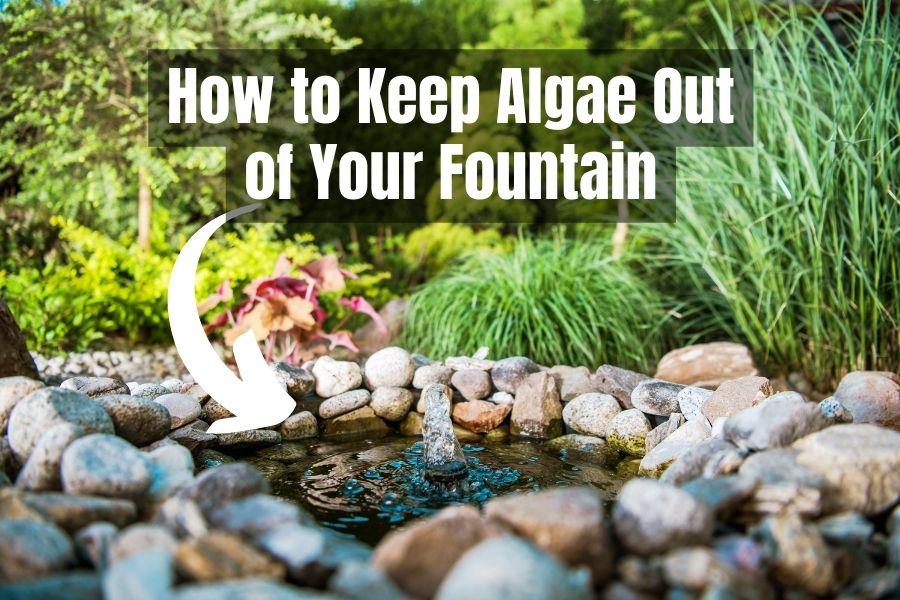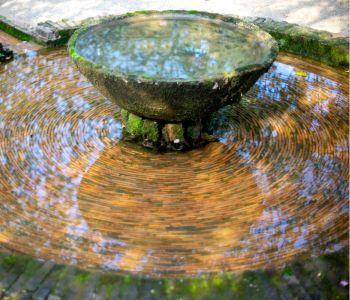Algae growth not only affects the aesthetic appeal of your fountain but can also clog pumps and pipes, leading to maintenance headaches.

What Aquatic Environments Encourage Algae Growth? Algae tend to flourish when conditions favor them, such as high temperatures, excess sunlight and nutrient-rich water. Poor circulation or stagnant water also encourages rapid algae growth in fountains.
Why is This a Problem? Allowing algae to grow unchecked in your fountain can lead to several issues. Excessive algae can clog filters, block sunlight from other plants, deplete oxygen and create an unsightly appearance, impacting the ecosystem balance.
Here are some efficient and environmentally responsible ways to stop and handle algae in your fountain – with less hassle.
Preventing Algae Growth in a Fountain
4 Tips for Keeping Fountains Free of Algae:

1. Location Matters: When choosing a setting for your fountain, opt for a site with partial sunlight. While fountains in direct sun may appear best, this can promote algae growth. Partial shade helps maintain the water temperature at a level that discourages algae proliferation.
2. Use Algae-Resistant Materials: Opt for natural stone, copper and glass-fiber reinforced concrete components for your fountain. Avoid porous materials that provide a breeding ground for algae.
3. Circulation and Aeration: Proper water circulation and aeration play a crucial role in algae prevention. Invest in a fountain pump that provides sufficient circulation, preventing stagnant water where algae thrive.
4. Balance Nutrient Levels: Algae thrive on organic components like nitrogen and phosphorus. Using a water treatment specifically for fountains can help control water nutrient levels. These emulsions are eco-friendly and safe for aquatic life.
Eco-Friendly Algae Control Methods

1. Beneficial Plants: Introduce aquatic plants to your fountain. Plants like water lilies and submerged oxygenators compete with algae for nutrients, effectively minimizing their growth.
2. Barley Straw: Barley straw is a natural algae inhibitor. As it decomposes, it expels compounds that impede algae growth. Place a small bale of barley grass in your water feature, and replace it every 2-3 months.
3. Natural Enzymes: Eco-friendly enzyme-based products break down organic matter that serves as algae food. Regular use of such products can prevent algae buildup.
4. Ultraviolet (UV) Clarifiers: UV clarifiers use ultraviolet light to disrupt the DNA of algae cells, preventing them from propagating. This method is both safe and highly efficacious in regulating the multiplication of algae in ponds, bird baths and fountains. Aquatic clarifiers are considered a reliable and environmentally friendly fix to combat algae-related issues.
Treating Algae Infestation
1. Manual Removal: If you notice algae starting to proliferate, act promptly. Use a soft-bristled brush or rag to disrupt and eradicate the growth without hurting the fountains surface.
2. Algae-Treating Tablets: There are algae-treating tablets available that are safe for plants and animals. Follow the manufacturer’s instructions for proper dosage and usage.
3. Hydrogen Peroxide Solution: Use a ratio of about 1 part hydrogen peroxide to 10 parts water to attack existing algae. Apply the solution, let it sit for a few minutes, and then completely rinse.
4. Vinegar Solution: A vinegar solution (1 part vinegar to 9 parts water) can be effective in treating algae. Apply the solution, scrub the affected areas, and rinse well.
Answers to Frequently Asked Questions:

Q: Can I use bleach to remove algae from my fountain?
A: While bleach can effectively kill algae, I don’t recommend it for fountains as it may harm aquatic life and corrode the fountain’s materials. Opt for eco-friendly alternatives like hydrogen peroxide or vinegar.
Firstly, bleach can harm creatures that swim in water. If your fountain has plants, fish or other water-living beings, the chlorine in bleach can hurt them. It can mess up the delicate balance of life inside the fountain and even kill these living things.
Secondly, bleach can mess up the materials that make your fountain. Lots of fountains are made from different stuff like stone, concrete, or metal. Bleach can deteriorate or wreck these surfaces over time. This might cause the fountain to break or change color, or simply look horrendous.
Instead of using bleach, go for friendlier options to disrupt algae without ruining your fountain.
Q: How often should I clean my fountain to prevent algae growth?
A: Regular maintenance is key. Aim for weekly cleanings by removing debris and scrubbing off any visible algae. This proactive approach will help prevent algae buildup.
While you tidy up, take out any leaves, sticks or other natural materials that have gathered in the fountain. This refuse can actually help algae grow by providing the right nutrients and an optimal environment for it to develop, so dispose of it!
You can use a brush or a sponge to carefully clean the spots where algae usually builds up, like the walls, edges, and any fancy parts of the fountain. Doing this regularly helps to stop algae from getting worse.
Keeping a steady routine for cleaning. If you keep taking out debris and clearing away the algae you can see, it’ll really lower the chance of re-growth in your fountain.
Q: Are there any fish that can help control algae in my fountain?
A: Yes, certain fish like goldfish and mosquito fish consume algae. However, keep in mind that they also require proper care and maintenance. Make sure your fountain is suitable for fish and provides adequate shelter and water conditions.
Q: Can I use algae-control chemicals in my fountain?
A: It’s best to avoid harsh chemicals that can harm aquatic life and the environment. Opt for eco-friendly algae control methods such as beneficial plants, UV clarifiers, barley straw and enzyme-based treatments.
Furthermore, enzymes can break down organic matter, (ie. dead algae or excess nutrients), which contribute to algae blooms. They also facilitate the decomposition of these substances, thus reducing the available aquatic nutrients and preventing overgrowth and spread.
Q: Can I run my fountain at night to prevent algae growth?
A: Operating your fountain at night might encourage algae growth if other protective steps aren’t taken. Pay attention to good circulation, aeration, and using materials that resist algae, along with regular upkeep. These actions help control algae, but if missed, night operation alone won’t stop its growth.
Conclusion:
Maintaining a clean and algae-free fountain doesn’t have to be a daunting task. By implementing these eco-friendly algae control methods and preventive measures, you can enjoy the beauty and serenity of your fountain without the hassle of algae buildup.
Last Updated April 26, 2024

